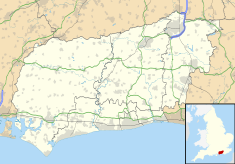Charles Cowles-Voysey was an English architect.

Worthing Borough Council is the local authority for Worthing in West Sussex, England. Worthing is a non-metropolitan district with borough status. It forms the lower tier of local government in Worthing, responsible for local services such as housing, planning, leisure and tourism. The council is currently led by the Labour Party. It is based at Worthing Town Hall.

Halifax Town Hall is a grade II* listed, 19th century town hall in the town of Halifax, West Yorkshire, England. It is notable for its design and interiors by Charles Barry and his son, Edward Middleton Barry, and for its sculptures by John Thomas. The town hall is also the headquarters of Calderdale Metropolitan Borough Council.

Cambridge Guildhall is a civic building in the centre of the historic city of Cambridge, England. It includes two halls, The Large Hall and The Small Hall, and is used for many disparate events such as comedy acts, conferences, craft fairs, live music, talks, and weddings. It is also used by the University of Cambridge for certain examinations. It is owned and managed by the Cambridge City Council, and it is their seat of government. The Guildhall is located on the south side of Market Hill, the market square in Cambridge, between Peas Hill to the west and Guildhall Street to the east. It is a Grade II listed building.

Rochdale Town Hall is a Victorian-era municipal building in Rochdale, Greater Manchester, England. It is "widely recognised as being one of the finest municipal buildings in the country", and is recorded in the National Heritage List for England as a designated Grade I listed building.

Trafford Town Hall is a neo-classical building in Stretford, Trafford, Greater Manchester, England. It is the meeting place of Trafford Council and was originally known as "Stretford Town Hall". The building faces Emirates Old Trafford to the south and is within 500 metres of Manchester United's Football Ground to the north.
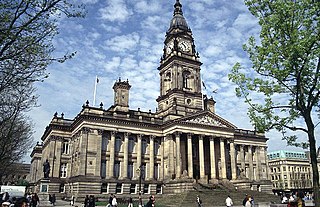
Bolton Town Hall in Victoria Square, Bolton, Greater Manchester, England, was built between 1866 and 1873 for the County Borough of Bolton to designs by William Hill of Leeds and George Woodhouse of Bolton. The town hall was extended in the 1930s to the designs of Bradshaw, Gass and Hope and has been designated a Grade II* listed building by English Heritage.

The Old Town Hall, Richmond on Whittaker Avenue in Richmond, London is a former municipal building which from 1893 to 1965 served as the town hall for the Municipal Borough of Richmond.

Berwick Town Hall is a municipal facility in Marygate, Berwick-upon-Tweed, England. The town hall, which was the headquarters of Berwick-upon-Tweed Borough Council, is a Grade I listed building.

Great Yarmouth Town Hall is a municipal building in Hall Plain, Great Yarmouth, Norfolk, England. The town hall, which is the meeting place of Great Yarmouth Borough Council, is a Grade II* listed building.

Newark Town Hall is a municipal building consisting of a town hall, assembly rooms and a market hall in Newark-on-Trent, Nottinghamshire, England. It is a Grade I listed building.
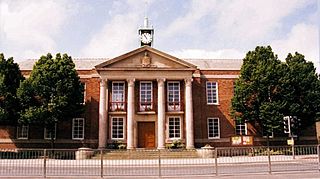
Padiham Town Hall is a municipal building in Burnley Road, Padiham, Lancashire, England. The town hall, which was the headquarters of Padiham Urban District Council, is a grade II listed building. It is the meeting place of Padiham Town Council.

Colne Town Hall is a municipal building in Albert Road, Colne, Lancashire, England. The town hall, which is the meeting place of Colne Town Council, is a grade II listed building.
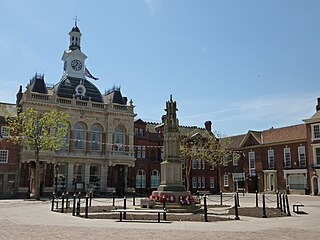
Retford Town Hall is a municipal building in The Square, Retford, Nottinghamshire, England. The town hall, which was the meeting place of Retford Borough Council, is a grade II listed building. It is still used for meetings of Bassetlaw District Council.

Bognor Regis Town Hall is a municipal building in Clarence Road, Bognor Regis, West Sussex, England. The town hall, which is the meeting place of Bognor Regis Town Council, is a Grade II listed building.

Brentwood Town Hall is a municipal building in Ingrave Road, Brentwood, Essex, England which serves as the headquarters of Brentwood Borough Council.
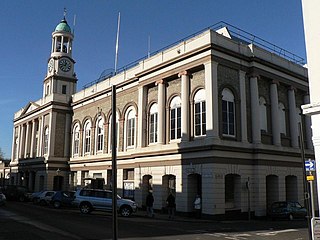
Ryde Town Hall is a municipal structure in Lind Street in Ryde, Isle of Wight, England. The town hall, which was the headquarters of Ryde Borough Council, is a Grade II listed building.

The Moot Hall is a municipal building in the High Street in Maldon, Essex, England. The building, which was the headquarters of Maldon Borough Council, is a Grade I listed building.
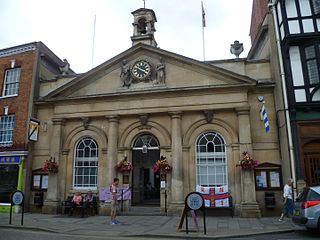
Tewkesbury Town Hall is a municipal building in the High Street in Tewkesbury, Gloucestershire, England. The building, which is the meeting place of Tewkesbury Town Council, is a Grade II* listed building.

The following is a timeline of the history of the borough of Worthing, West Sussex, England.

